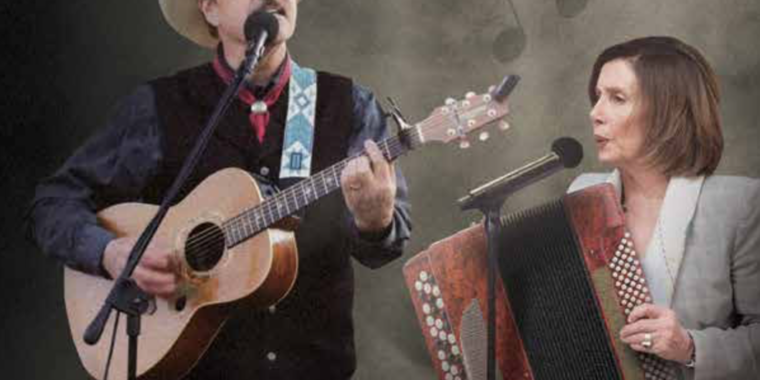

/ An image from the RNC flyer. We’re quite sure that our use of this image is fair, since we’re engaging in comment and criticism about this photo and its role in the lawsuit.
RNC / Erika Peterman
When Erika Peterman saw photographs she had taken in a flyer put out by the Republican National Committee, she wasn’t happy about it. Peterman was a supporter of Rob Quist, the Democratic candidate for Montana’s at-large seat in Congress in the 2017 special election. The Montana Democratic Party had hired Peterman to take photographs of Quist at a Democratic Party event. The photographs showed Quist wearing a cowboy hat and holding a guitar.
The RNC had downloaded three of the photos from Quist’s campaign Facebook page and used them in a campaign mailer attacking Quist. Peterman sued the Republican Party, arguing that the mailer infringed her copyright. But in a February ruling, a federal judge rejected Peterman’s arguments, ruling that the Republicans’ use of her image was fair use.
“The mailer uses Quist’s musicianship to criticize his candidacy, subverting the purpose and function” of Peterman’s original photographs, Judge Dana Christensen wrote. Her ruling noted that Peterman had charged the Montana Democrats a flat $500 to cover the event and had published the photographs on social media, suggesting that she had no expectation of making further money from them.
Fair-use rights can be significant in a case like this one, where one candidate is openly criticizing the other. Presumably, if the RNC had asked the Quist campaign for permission to use the photographs, the campaign would have said no, regardless of the price. Peterman likely would have said no as well. Yet allowing candidates to use each others’ media to criticize one another is likely to promote healthy democratic debate—exactly the kind of situation the fair-use doctrine was designed to address.
The ruling has important limitations
There’s also an obvious potential concern for photographers here, though. Photographers often seek to earn a living by licensing copies of their photographs for publication, but it’s easy for someone to download a photograph without worrying about who created it. In this case, the Quist campaign didn’t include any notices indicating that Peterman was the photographer—or that she had retained ownership of the copyrights.
But for photographers worried about this ruling eviscerating their rights, it has some welcome limitations.
The photographs showed Quist holding a guitar. The RNC mailer stated that “for Montana conservatives, liberal Rob Quist can’t hit the right note.” It also photoshopped in an image of Nancy Pelosi playing an accordion, stating that Quist was “music to Nancy Pelosi’s ears.”
The message was a bit ham-fisted, perhaps, but it was directly linked to the contents of the photographs. A generic image of Quist from another photographer would not have served the same purpose, because the RNC might not have otherwise been able to obtain images of Quist playing a guitar. This means that candidates don’t necessarily have free rein to use images of their opponents. A fair use must be tailored to the contents of a given photograph.
Also, the precedent here is likely to be limited to political campaigns. Fair-use law gives the narrowest latitude to commercial publishers, while people engaged in political speech get the broadest latitude under copyright law. So a for-profit company using a competitor’s image without a license to criticize that competitor’s products might not get such favorable treatment from the courts.









